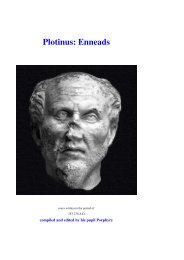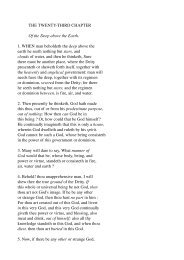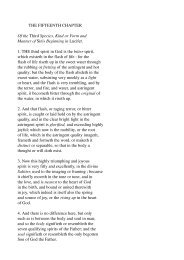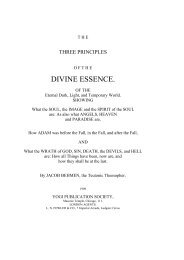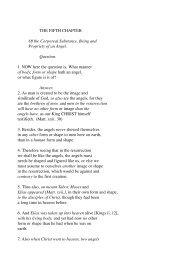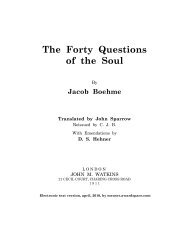Gerald Massey's Lectures - Society in evolution - Awardspace
Gerald Massey's Lectures - Society in evolution - Awardspace
Gerald Massey's Lectures - Society in evolution - Awardspace
You also want an ePaper? Increase the reach of your titles
YUMPU automatically turns print PDFs into web optimized ePapers that Google loves.
on the third day follow<strong>in</strong>g the crucifixion. In the Acts he is not "taken up" <strong>in</strong>to Heaven<br />
until the fortieth day, or after forty days! Such serious discrepancies as these are forever<br />
irreconcilable as history, but they are found to conta<strong>in</strong> the very facts that reconstitute the<br />
Mythos.<br />
The resurrection of Osiris at the Autumn equ<strong>in</strong>ox was lunar; at the vernal equ<strong>in</strong>ox it was<br />
solar. After he was betrayed to his death, when the sun was <strong>in</strong> the sign of Scorpio, he rose<br />
aga<strong>in</strong> on the third day as Lord of Light <strong>in</strong> the moon, or as Horus, the child of the mothermoon.<br />
The solar resurrection was at the vernal equ<strong>in</strong>ox when the sun entered the first of<br />
the upper signs and Orion rose. This time it was <strong>in</strong> the character of the second Horus, the<br />
adult of 30 years; and this second resurrection followed the forty days of mourn<strong>in</strong>g for<br />
the suffer<strong>in</strong>g God which were celebrated <strong>in</strong> the Mysteries, and survive <strong>in</strong> a Christianized<br />
form as our Lent. And just as the myth of the double Horus <strong>in</strong> the two characters of the<br />
child of 12 years, and the adult Horus of 30 years, has been cont<strong>in</strong>ued <strong>in</strong> the Gospels to<br />
furnish the two phases <strong>in</strong> the life of Jesus, so have the two different resurrections with<br />
their correct dates been applied to the Christ made historical.<br />
Thus <strong>in</strong>terpreted by means of the Mythos these two versions of one alleged fact tend to<br />
corroborate my explanation already made that the two different dates for the crucifixion<br />
given <strong>in</strong> the otherwise irreconcilable accounts belong to the luni-solar reckon<strong>in</strong>g <strong>in</strong> the<br />
same luni-solar myth. In Egyptian the signs of a half-moon and fourteen days are<br />
identical; and <strong>in</strong> the dark half of the moon Osiris was torn <strong>in</strong>to fourteen parts. Therefore<br />
the 14th of the lunar month was the day of full moon. Whereas <strong>in</strong> the soli-lunar month of<br />
thirty days the 15th was the middle of the month. Now the crucifixion or the cross<strong>in</strong>g at<br />
Easter was and still is determ<strong>in</strong>ed by the day of full moon. This will be on the 14th of the<br />
month of twenty-eight days <strong>in</strong> the reckon<strong>in</strong>g by the moon only, but on the 15th of the<br />
month accord<strong>in</strong>g to the soli-lunar reckon<strong>in</strong>g. The 14th of the month would be the lunar<br />
reckon<strong>in</strong>g of Anup = John, and the 15th that of Taht-Mati = Mathew <strong>in</strong> the two forms of<br />
the Egyptian Mythos. Both reckon<strong>in</strong>gs were extant <strong>in</strong> two different cults and both were<br />
separately cont<strong>in</strong>ued by the Eastern and Western Churches for the one day of the<br />
crucifixion. Both cannot be historically correct, but they are both astronomically true.<br />
Both could be made to meet at a given po<strong>in</strong>t <strong>in</strong> the total comb<strong>in</strong>ation which was<br />
determ<strong>in</strong>ed by the conjunction of the sun and moon at the equ<strong>in</strong>ox as the day of full<br />
moon. But the two different dates for the mid-month rema<strong>in</strong>ed, and these are represented<br />
by the traditions of two different dates for the crucifixion. Both the lunar and the solar<br />
dates could be utilised by the Mythos, <strong>in</strong> which there were two crucifixions and two<br />
resurrections, though these will bear witness for the s<strong>in</strong>gle fact of the historical<br />
crucifixion. As we have seen, the two ascensions of Osiris on the third day and at the end<br />
of forty days, have been preserved, and are repeated as historical transactions. Two<br />
different Crosses were also conta<strong>in</strong>ed <strong>in</strong> the Christian Iconography as the cross of<br />
Autumn and of Easter; and although we may not be able to show two crucifixions <strong>in</strong> the<br />
Canonical Gospels, nevertheless the total matter of the Mythos is there. When Jesus was<br />
led up <strong>in</strong>to the wilderness to be tempted of the devil, and to suffer dur<strong>in</strong>g forty days, we<br />
have the parallel to the struggle between Osiris and Sut, which was celebrated dur<strong>in</strong>g the<br />
forty days of mourn<strong>in</strong>g <strong>in</strong> the mysteries. Moreover, there were two days of death or<br />
crucifixion kept <strong>in</strong> Rome until the present century, when the dead Christ used to be laid<br />
out and exhibited on the Thursday before Good Friday; and two days of resurrection were<br />
also celebrated <strong>in</strong> the two Sabbaths on Saturday and Sunday. As the Apostolic<br />
Constitutions show, both of these days were cont<strong>in</strong>ued for the two weekly holidays of the<br />
Christians, Saturday be<strong>in</strong>g the day of ris<strong>in</strong>g aga<strong>in</strong> on the 7th day of the week <strong>in</strong> the lunar<br />
cult; Sunday, the Sabbath of the 8th day, accord<strong>in</strong>g to the solar resurrection. Such are the<br />
fundamental facts; and, to my th<strong>in</strong>k<strong>in</strong>g, they are of sufficient force to cleave the<br />
Canonical history right <strong>in</strong> two, each half be<strong>in</strong>g then claimed by the Mythos. Here, as<br />
elsewhere, the Mythos does expla<strong>in</strong> the fact, but only by abolish<strong>in</strong>g the history. From



